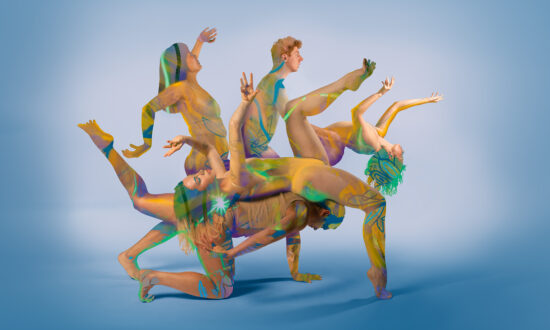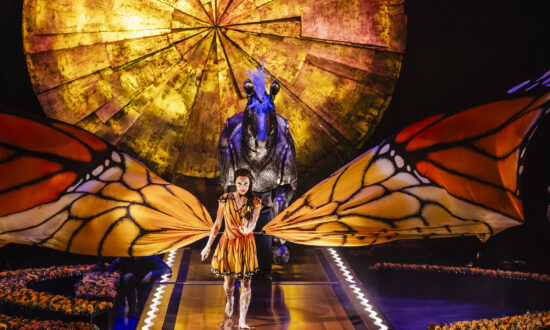The Oxford Dictionary defines convergence as “the process of moving together from different directions and meeting” – not an easy task in current climes. But determination and online conferencing technology has enabled choreographers based in South Africa, Germany and the Netherlands (the 2018, 2019 and 2020 winners of the prestigious International Choreographic Competition Hannover) to work with ADT dancers and bring their ideas to life on the Australian stage.
The first of the three duets is O, by German choreographer Philippe Kratz. The two dancers (Sophie Stuut and Zoe Wozniak) enter separately, moving individually with tiny fluid steps as a ministerial voice repeatedly chants Genesis 11:4, “Come let us build ourselves a city… lest we be scattered abroad on the face of the whole earth”. The voice is gradually interrupted by snatches of other voices and gasps of breath until the biblical language falls away, the electronic backbeat taking over and the dancers coming together in an exquisitely synchronised sequence of futuristic dance moves, at once sinuous and robotic. Finally they meld into one carefully balanced machine, operating as a single entity.
O is a boldly original piece that feels timeless yet sings with contemporary energy.

Philippe Kratz’s O is a boldly original work. Photo: Sam Roberts Photography
The second duet is Trial, by Vietnamese choreographer Tu Hoang, a perfectly crafted exploration of proximity and distance, conformity and individuality. Dressed in shirts and suit pants like office workers, the dancers (Mason Kelly and Darci O’Rourke) begin with a sequence of tai-chi-influenced moves, their voices making mechanical sound effects as their limbs twist and flex in perfectly synchronised, intricate manoeuvres. As the background music (Rorschach by Loscil) kicks in, the synchronicity is interrupted and the dancers start to move individually, sometimes frenetic, sometimes sliding into slo-mo, finally running side by side, Kelly falling behind, stopping, O’Rourke turning, walking back, the two returning to their initial synchronised pattern.
Road, by South African choreographer Oscar Buthelezi, takes us on an intensely powerful journey: of discovery, of history of intimate and global relationships. With lithe, writhing movements and an almost birdlike curiosity, dancers Kimball Wong and Rowan Rossi step into the circle of light at the centre of the stage, the meeting place. The wonderfully atmospheric soundscape (Max Richter) is a curious mix of electronic and organic, pulsing drumbeats and static noise, interrupted with bursts of hurried footsteps, a clanging bell or gentle piano music.
The dancers in Road explore each other, watching or demonstrating, eventually joining together in harmonious movement and elegant balance. The simple costume of brown trunks renders every flexed muscle, every stretched sinew visible, but their near-nakedness gives them a poignant vulnerability despite their evident strength. The piece ends with Wong crouched down, Rossi standing balanced on his thighs, leaning forward into a rushing electronic wind like a figurehead at the prow of a ship, raising his arm to point into the distance.
Iti is a beautifully conceived exploration of Aboriginal history
The fourth piece, Iti, is an ensemble performance by members of South Australia’s newest dance company, the South Australian First Nations Dance Collective (Janelle Egan, Thomas Fonua, Kenneth Johnson and Rikki Milera-Wilson), directed by choreographer Gina Rings. Inspired by the music of the highly acclaimed Electric Fields, Iti is a beautifully conceived exploration of Aboriginal history, from stolen land, stolen history and stolen children, to ongoing resilience and celebration of culture.
Iti begins with a single dancer crouched in front of a cerulean-blue sky, her shadow-image cast into the clouds as she bends, sways and gestures. She is joined by the other dancers, who line up together and move in syncopated rhythm, or break away to spin across the stage, or to fetch a bark coolamon filled with white ochre which is applied to arms and face. Traditional and contemporary dance forms are woven together as the shadows of the story-tellers are imprinted on the scrolling backdrop of Australian bush, desert and waterways.
The final performance is an exciting new work from ADT’s 2021 associate artist, Adrianne Semmens. Titled Immerse, it draws on Semmens’ Barkindji background and her connection to the rivers and waterholes of her homeland, but is ultimately an honouring of all water as healer, life-giver and powerful elemental force.

Mason Kelly in Immerse by Adrianne Semmens. Photo: Sam Roberts Photography
Immense begins with the fluid sounds of a gurgling stream and a dancer crawling across the stage, unspooling a reel of blue cotton rope in a line behind her. It serves as a kind of map of a river, at one point stretched out into the wings and pulled, to symbolise movement, as a dancer lying on the stage “walks” beside it. This innovative use of different planes is further explored when two dancers (one upright, one prostrate) walk together, feet touching, steps matched, even though they’re moving in different dimensions – the ancestors travelling with the living. Dressed in blue and green, the dancers sometimes become the sea, moving organically in one roiling mass, rhythmically in lines, with a synchronised flicking of sleeves, or standing, feet rooted, bodies wavering in the pull of an unseen force.

Get InReview in your inbox – free each Saturday. Local arts and culture – covered.
Thanks for signing up to the InReview newsletter.
The finale is simple but ingenious; a dancer on all fours, his back heaped with a pile of blue pebbles. As he makes his way across the stage, the stones slide and scatter, creating a visual waterway and a tidal soundscape. Pebbles dispersed, he rises to his feet as a long stream of tiny pebbles rains down from the gods in a visual and aural cloudburst. This inspired use of one element to represent another is the perfect culmination of a program jam-packed with innovation, big thinking and precise, controlled execution.
Australian Dance Theatre’s Convergence is being presented at The Odeon, Norwood, until Saturday, May 8.
Support local arts journalism
Your support will help us continue the important work of InReview in publishing free professional journalism that celebrates, interrogates and amplifies arts and culture in South Australia.
Donate Here



